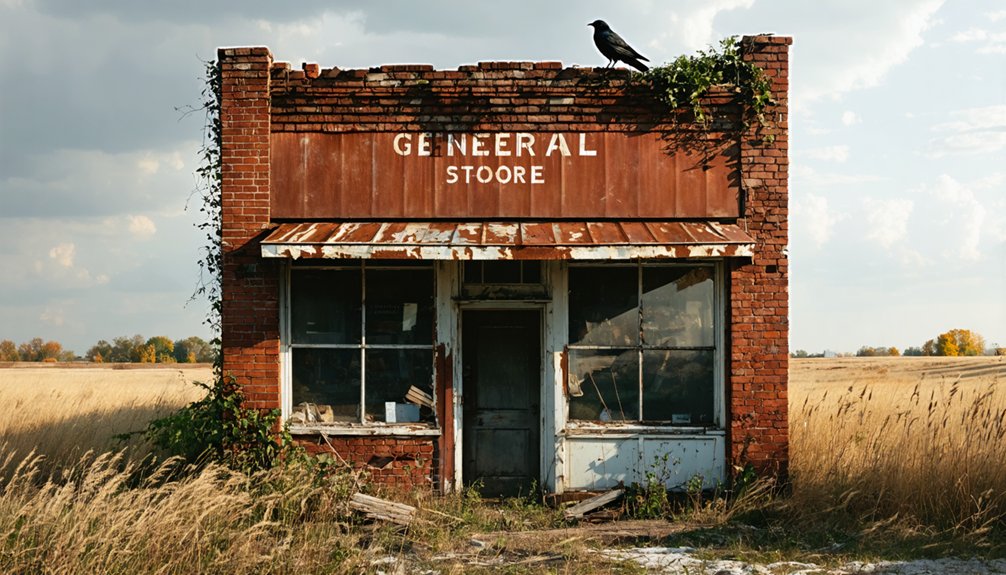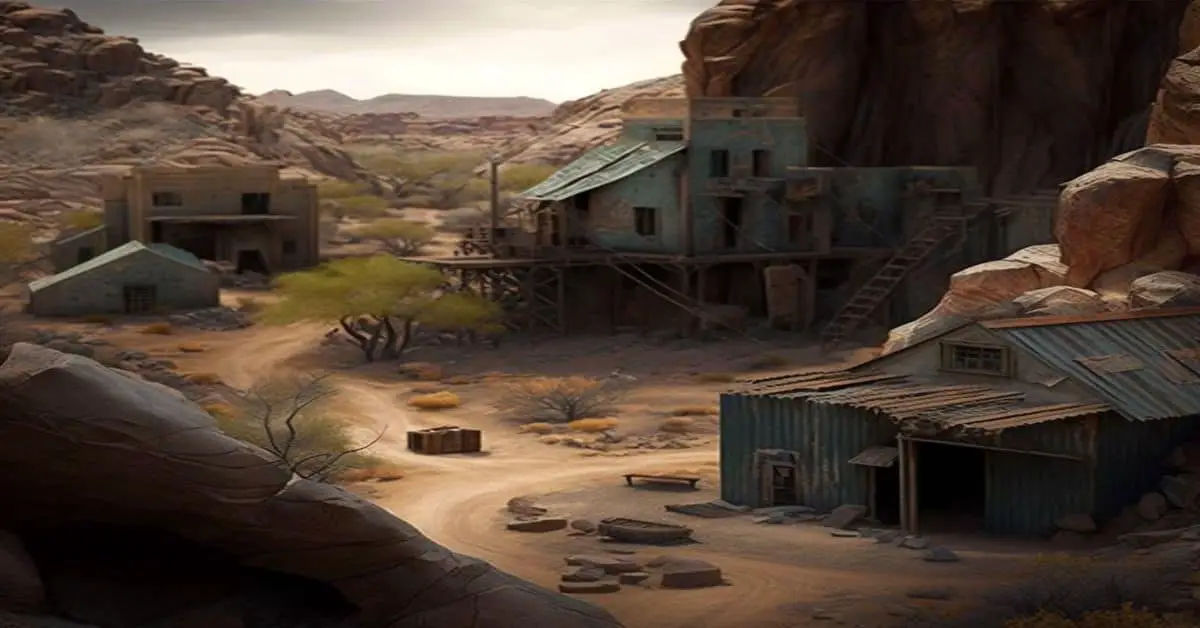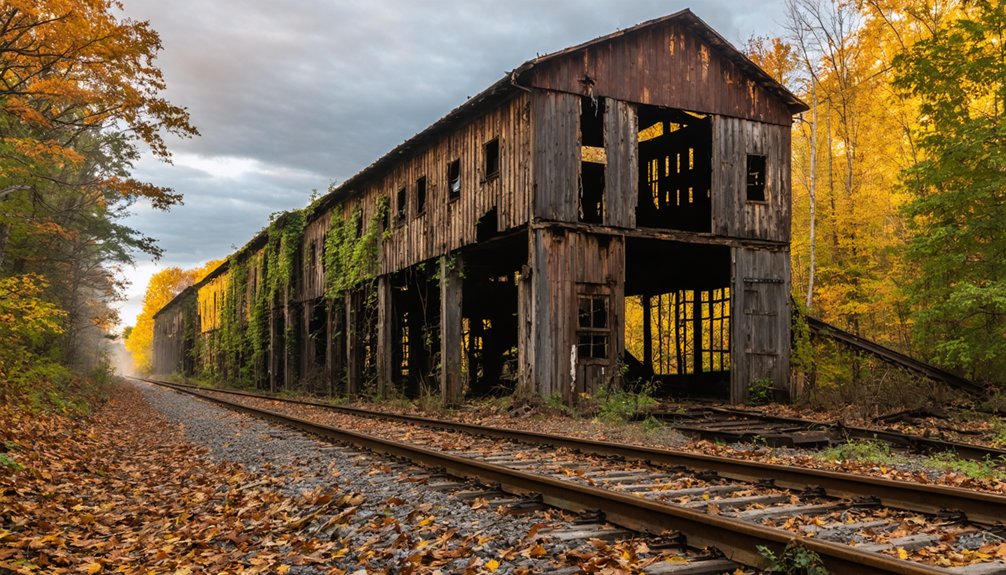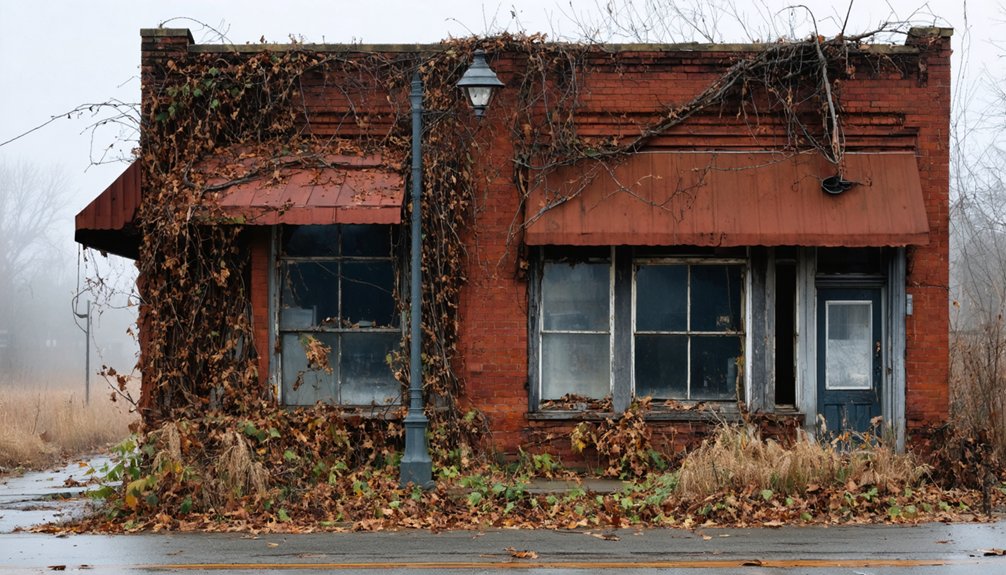You’ll find Sheff in Lawrence County, Indiana – a ghost town that once thrived as a crucial railroad junction where the New York Central and Big Four railroads met. In the early 1900s, it served as a bustling control point for train movements and coal transport to Indiana’s steel mills. The town’s decline began in the 1960s with railroad industry changes, leaving behind scattered foundations and overgrown lots. Local tales of unexplained phenomena now echo through its abandoned grounds.
Key Takeaways
- Sheff was a vital railroad junction town in Lawrence County, Indiana that became abandoned following railroad industry restructuring in the 1960s.
- The ghost town’s primary economic function centered around coal transport operations for steel mills in Indiana Harbor and Gary.
- By the 1990s, one-third of Sheff’s properties were vacant, with crumbling infrastructure and abandoned buildings dominating the landscape.
- Only scattered foundations, overgrown lots, and traces of former roadways remain at the site today.
- Local legends include supernatural sightings of a veiled woman, a wailing “dog-faced woman,” and mysterious orbs along abandoned roads.
The Lost Settlement of Sheff
Situated at an essential railroad junction where the New York Central Railroad intersected with its subsidiary line, Sheff emerged as a strategic control point in Lawrence County, Indiana.
The vital railway intersection at Sheff controlled the flow of trains through southern Indiana’s expanding rail network.
You’ll find this ghost town’s history deeply intertwined with America’s railroad expansion, as it served primarily as a significant control tower location managing train movements through the crossing.
Unlike other settlements that grew from agriculture or industry, Sheff’s significance stemmed from its role in railway operations.
The town’s proximity to clean drinking water made it an ideal location for early railroad workers and their families to settle.
Similar to the rise of Bellaire Canal Town, Sheff’s development was tied directly to transportation infrastructure, though through rail rather than waterways.
You can trace the town’s brief existence to the rise and fall of railroad prominence in southern Indiana.
While few physical structures remain today, Sheff’s story mirrors many similar railroad communities that flourished during the golden age of rail transportation, only to fade as technological advances made their functions obsolete.
Historical Records and Documentation
You’ll find the historical documentation of Sheff particularly challenging due to gaps in primary source materials and scattered records across multiple county archives.
Similar to Pine Township’s early records, the town’s development relied heavily on lumber enterprises, with sawmills serving as economic drivers until local timber resources were depleted.
Researchers have worked to reconstruct Sheff’s timeline by cross-referencing surviving township documents, land plats, and postal records from the Tippecanoe County Historical Society.
Local historians’ efforts to recover lost records have included collecting oral histories from descendants of early settlers and examining neighboring communities’ documentation that mentions Sheff. The area’s earliest documented settlement occurred when Mrs. Richard Baker taught the first school in Sheffield Township in 1825.
Primary Source Challenges
Researching the history of Sheff, Indiana presents significant challenges when it comes to primary source documentation. You’ll find that many records from this ghost town weren’t properly preserved, leading to potential historical inaccuracies in what we understand about the settlement.
The limited digital archives and deteriorating physical documents make it difficult to piece together Sheff’s complete story. Modern digitization efforts using tools like the Canon 5D camera have helped preserve what remaining documentation exists. You’ll need to rely on partnerships with local archives and historical societies to access what documentation remains.
Community engagement has proven essential, as oral histories passed down through generations help fill gaps in the written record. If you’re looking to verify information about Sheff, you’ll discover that authentication can be particularly challenging due to inconsistent record-keeping practices of the era and limited access to original documents.
Lost Records Recovery Methods
When recovering lost historical records about Sheff, Indiana, multiple methods prove vital for piecing together the town’s past.
You’ll find valuable information through digital archival techniques, including searches of online library databases and digitized historic maps like Sanborn and Beers collections. Title searches can reveal ownership patterns, while aerial photographs help verify physical site characteristics. Local historical societies can provide unique insights and resources not found in standard archives.
Document preservation plays an important role in protecting what’s been found.
You’ll need to maintain proper temperature and humidity controls around 70°F and below 50% respectively. For water-damaged materials, specialized recovery services using freeze-drying methods can save critical documents.
Creating a thorough research database helps track your findings, while following proper excavation protocols guarantees any physical artifacts are properly documented and preserved for future study.
Life Before Abandonment
During its prime in the early 20th century, Sheff thrived as an essential railroad hub where two major rail lines intersected in rural Benton County, Indiana.
You’d find the town’s heart at its interlocking tower, built around 1906, where workers controlled the critical crossing of the New York Central and Big Four railroads. Similar to how river commerce once shaped transportation in Lawrence County towns, a bustling transfer yard just north of the tower saw constant activity as trains assembled and distributed coal heading to the steel mills of Indiana Harbor and Gary.
Life in Sheff centered entirely around the railroad’s pulse. The town’s residents, most employed by the railways, lived atop a glacial moraine at 764 feet elevation, surrounded by farmland. Following Creative Commons guidelines, the history of this community has been preserved through collaborative documentation.
While the community wasn’t large, it played a crucial role in the region’s industrial supply chain, particularly in coal transport operations.
Economic Decline and Population Exodus
Sheff’s decline began in the late 1960s as the American railroad industry faced widespread restructuring.
Like its neighbor Gary, economic factors hit Sheff hard as industries shuttered their doors and jobs vanished. You’d have seen families packing up their homes, leaving behind empty streets and abandoned buildings.
Streets once bustling with life grew silent as families fled, leaving behind hollow homes and shattered dreams.
The mass exodus mirrored Gary’s devastating 62% population loss, transforming a once-vibrant community into a shell of its former self. Automation and foreign steel competition devastated the region’s industrial workforce throughout the 1970s.
Despite attempts at community resilience, the town couldn’t overcome the crushing weight of unemployment and diminishing resources. The Lake Michigan shore location that once symbolized industrial prosperity became a stark reminder of economic collapse.
By the 1990s, you’d have found a third of properties vacant, infrastructure crumbling, and essential services dwindling.
The stark reality of industrial decline left Sheff, like many Rust Belt towns, struggling to maintain any semblance of its previous liveliness.
Natural Features and Geographic Location
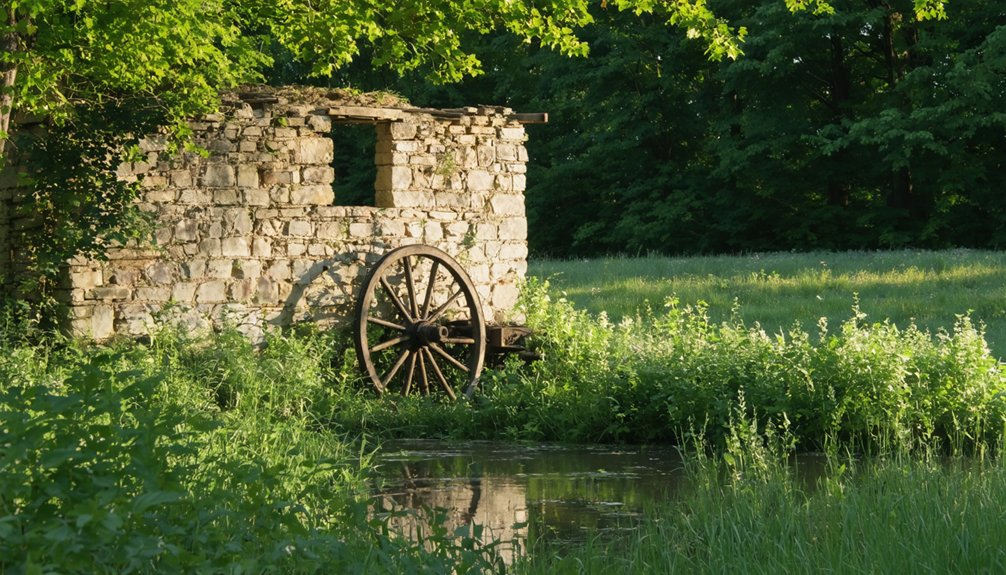
You’ll find Sheff positioned atop a terminal moraine, marking the last glacial boundary in northwestern Indiana with its distinctive rolling terrain and elevated landforms.
The town’s surrounding landscape reflects the region’s glaciated plains, with a mix of flat and undulating topography that was once dotted with wetlands, including the now-drained Beaver Lake to the north.
The strategic placement of Sheff at the intersection of the New York Central and Big Four railroad lines took advantage of the area’s stable ground conditions, making it an ideal location for rail transport infrastructure.
Surrounding Landscape Features
The terminal moraine landscape of northern Indiana shapes Sheff’s distinct geographical setting in York Township, Benton County.
You’ll find this ghost town perched near the crest of rolling hills formed by ancient glacial deposits, standing in stark contrast to the surrounding flatlands. The moraine topography creates a natural elevation that’s unique to this part of the region.
The glacial influence extends beyond the visible landscape, affecting everything from soil composition to local water drainage patterns.
You’re in an area that once bordered the historic Beaver Lake, now drained, and you’ll notice a network of small creeks and drainage ditches carved by glacial meltwater.
While the original hardwood forests have largely given way to farmland, remnant woodlots still dot the agricultural expanse, preserving hints of the area’s natural heritage.
Transportation Routes Nearby
At the convergence of major railway lines, this ghost town‘s strategic location atop the terminal moraine made it an ideal transportation hub in northern Indiana.
The transportation significance of Sheff centered on its critical railway intersections, where the New York Central and Big Four railroads met the Chicago, Indiana & Southern line.
You’ll find evidence of this once-bustling junction at coordinates 40°42′20″N 87°26′57″W in Benton County’s York Township.
- The railway crossings transformed Sheff into a crucial link for coal transport to Indiana Harbor’s steel mills.
- The 1906 construction of the Chicago, Indiana & Southern railway expanded the town’s reach.
- A large transfer yard north of the interlocking tower facilitated regional commerce.
- The interconnected rail system made Sheff fundamental to Indiana’s industrial growth.
Remaining Structures and Artifacts
While no official records detail Sheff’s current structures, modern surveys of Indiana ghost towns suggest minimal physical remnants exist at the site.
If you’re searching for remaining structures, you’ll likely encounter only scattered foundations, overgrown lots, or traces of former roadways typical of abandoned Indiana settlements.
You won’t find documented historical artifacts specific to Sheff in public collections.
Like many ghost towns across Indiana, any surviving items are probably on private property and inaccessible.
The most common remnants you might discover would be foundation stones or simple markers, though even these aren’t confirmed.
Without preservation efforts or official protection, nature has likely reclaimed most evidence of Sheff’s existence, following the pattern of numerous other forgotten Indiana communities that have vanished from the landscape.
Local Legends and Stories
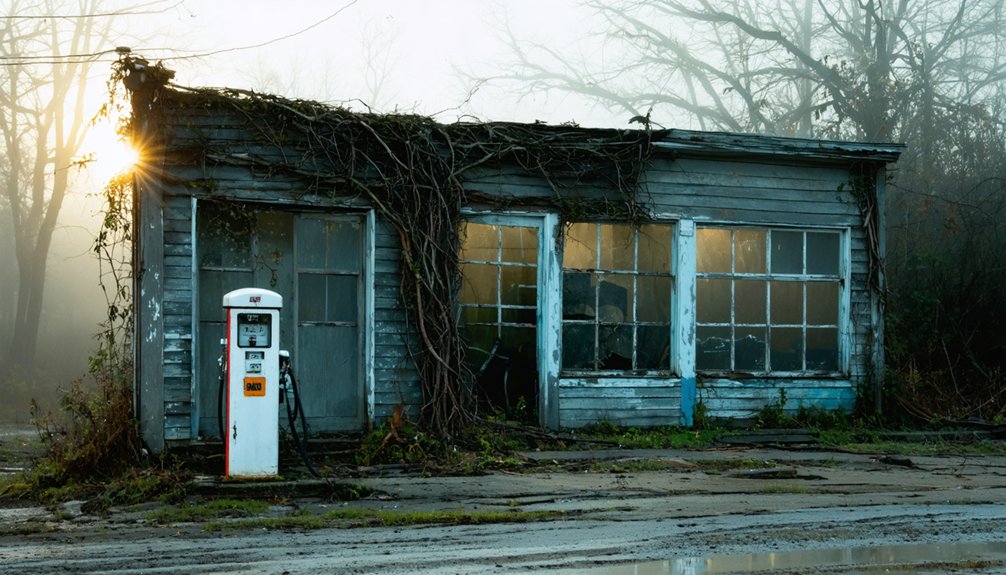
Like many abandoned Indiana settlements, Sheff has become fertile ground for supernatural tales and ghostly encounters that persist in local folklore. Along its empty lanes and forgotten homesteads, you’ll find stories that blend tragedy with mystery, keeping the town’s memory alive through haunted legends.
- Reports describe ghostly sightings of a veiled woman rising from the remnants of the old cemetery, causing nearby vehicles to stall mysteriously.
- Local ghost hunters share accounts of a wailing “dog-faced woman” appearing in wooded areas after sunset.
- Bridge crossings near Sheff feature tales of a grieving mother searching eternally for her lost child.
- Witnesses claim to see unexplained orbs of light and shadowy figures moving along abandoned roads, particularly during moonlit nights.
The stories echo similar supernatural accounts across Indiana’s ghost towns, connecting Sheff to the state’s rich paranormal heritage.
Preservation Efforts and Current Status
Because of limited resources and documentation, preservation efforts for Sheff face significant challenges in maintaining its historical legacy.
While no specific preservation strategies currently exist for Sheff, opportunities through Indiana Landmarks and the state’s Historic Preservation Review Board could provide essential support for future initiatives.
Indiana Landmarks and the state’s Historic Preservation Review Board offer vital pathways to protect Sheff’s historical legacy for future generations.
You’ll find that successful preservation often depends on community involvement, with local fundraising and partnerships playing integral roles.
Grant programs, including models like the Standiford Cox grants and the Black Heritage Preservation Program, offer potential funding pathways.
To move forward, Sheff needs a thorough assessment of its remaining structures and historical significance, along with sustainable maintenance plans.
Legacy in Indiana’s Ghost Town History
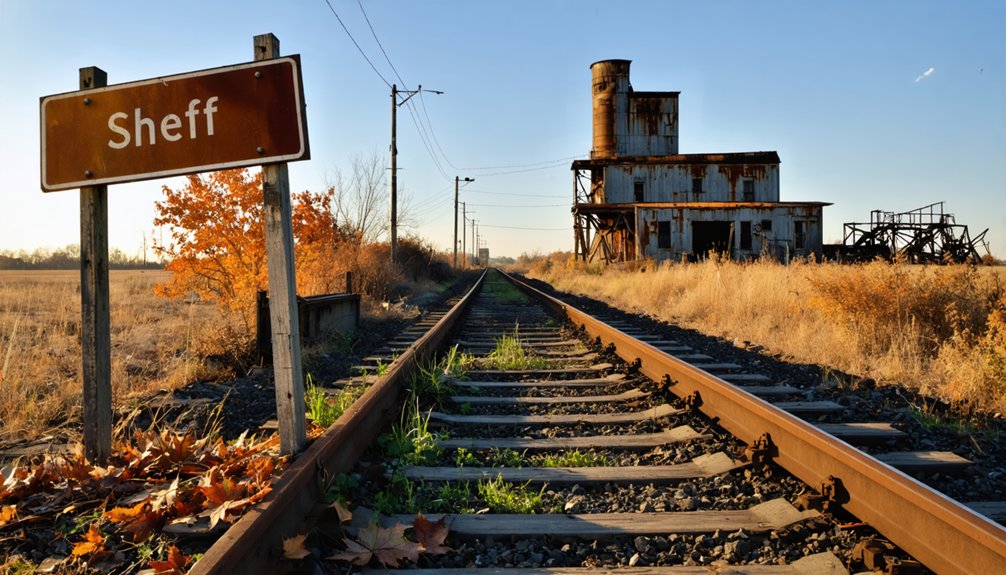
Sheff’s place among Indiana’s ghost towns tells a distinctive story of railroad-driven rise and decline. Among the state’s 41 documented ghost towns, Sheff stands out for its industrial significance rather than the typical causes of abandonment like disease or economic failure.
You’ll find its legacy deeply woven into the community dynamics of Benton County and Indiana’s broader transportation history.
- You can trace Sheff’s essential role in powering Indiana’s steel industry through its strategic coal transport operations.
- You’ll discover how Sheff’s interlocking tower symbolized technological advancement in railroad safety.
- You’re witnessing the lasting impact of its rail junction on regional industrial growth.
- You’re exploring a unique example of how transportation infrastructure shaped community survival.
Unlike other ghost towns born from failed commerce or health crises, Sheff’s story reflects the evolution of America’s changing industrial landscape.
Frequently Asked Questions
Were There Any Documented Supernatural Occurrences in Sheff’s Abandoned Buildings?
While you’ll find reports of shadowy figures and strange sounds, there aren’t specific documented ghost sightings in Sheff’s buildings. Paranormal investigations in similar Indiana ghost towns suggest potential activity.
What Role Did Native American Communities Play in Sheff’s Early Development?
You’ll find countless traces of Native heritage in Sheff’s foundations, as Miami and Potawatomi peoples originally inhabited this land, though cultural exchange diminished after forced removals in the 1830s.
Did Any Famous Historical Figures Ever Visit or Live in Sheff?
You won’t find any documented famous visitors or historical figures who lived in Sheff. The town’s significance remained focused on railroad operations rather than attracting notable personalities throughout its existence.
What Natural Resources or Industries Were Unique to Sheff’s Local Area?
You’ll find the area wasn’t uniquely resource-rich. While timber resources and agricultural industries existed regionally, Sheff’s main distinction was its strategic railroad junction and transfer operations.
How Did World War I and II Impact the Community of Sheff?
While you might think Sheff survived the wars unscathed, both conflicts drained your community’s workforce, weakened the local war economy, and tested community resilience as young residents left for urban opportunities.
References
- https://www.youtube.com/watch?v=45D4dbASJyE
- http://freepages.rootsweb.com/~gtusa/history/usa/in.htm
- http://ingenweb.org/inlawrence/abandoned.htm
- http://genealogytrails.com/ind/lawrence/ghosttowns.html
- https://en.wikipedia.org/wiki/List_of_ghost_towns_in_Indiana
- https://kids.kiddle.co/List_of_ghost_towns_in_Indiana
- https://www.wikiwand.com/en/articles/List_of_ghost_towns_in_Indiana
- https://www.onlyinyourstate.com/experiences/indiana/ghost-towns-in
- https://a.osmarks.net/content/wikipedia_en_all_maxi_2020-08/A/Sheff
- https://storymaps.arcgis.com/stories/9a3b3f4a63ba4031a46cb53907a0515c
